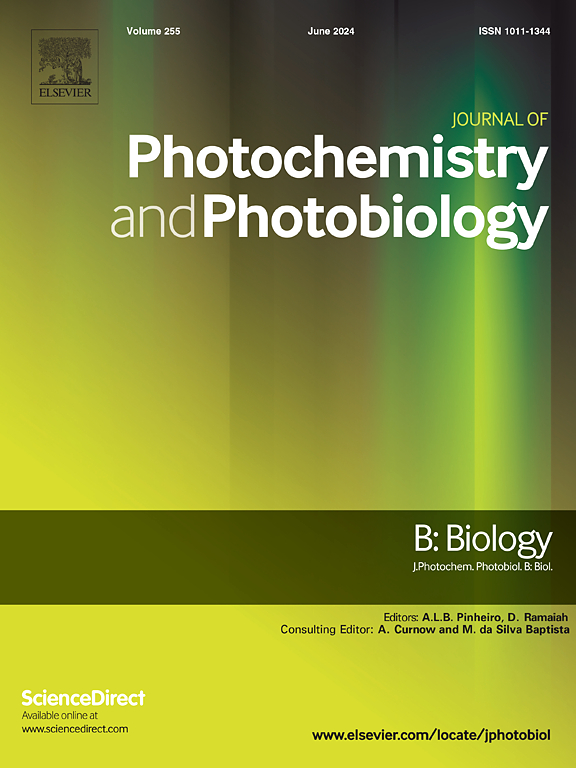Quinolinium-substituted porphyrins as promising antimicrobial photosensitizers
IF 3.7
2区 生物学
Q2 BIOCHEMISTRY & MOLECULAR BIOLOGY
Journal of photochemistry and photobiology. B, Biology
Pub Date : 2025-09-30
DOI:10.1016/j.jphotobiol.2025.113275
引用次数: 0
Abstract
Characterized by a remarkable chemical versatility and outstanding photophysical properties, porphyrins stand out as one of the most promising classes of photosensitizers for antimicrobial photodynamic therapy (aPDT). In this work, we described the synthesis, as well as the chemical and photophysical characterization of quinolinium-substituted porphyrins, and their corresponding Zn(II) complexes. The efficacy of these porphyrins in the photoinactivation of bacteria was evaluated, both alone and combined with the co-adjuvant potassium iodide, against methicillin-resistant Staphylococcus aureus (MRSA, Gram-positive) and Escherichia coli (Gram-negative) strains.
Overall, the results demonstrated the high potential of both cationic porphyrins to effectively photoinactivate bacterial strains. Cationic derivative 2, at a concentration of 1.0 μM, achieved reductions exceeding > 99.99999 % (>7.0 log10 CFU mL−1) for S. aureus after 10 min of white light irradiation (25 mW cm−2) and > 99.9 % (3.52 log₁₀ RLU) for E. coli after 60 min aPDT treatment. Similarly, the Zn(II) counterpart 2a also showed excellent efficiency, achieving ∼99.999 % reduction (4.95 log10 CFU mL−1) against MRSA after 60 min of aPDT at 1.0 μM, and a 3.52 log₁₀ RLU reduction for E. coli after 30 min of PDT at 5.0 μM. The action mechanism of both cationic quinolinium-substituted porphyrins demonstrated to be dependent on the singlet oxygen production, consistent with a Type II photodynamic pathway. The use of potassium iodide (KI) as co-adjuvant led to the production of reactive iodine species (RIS), namely iodine, and increased the photodynamic effect.

喹啉取代卟啉作为有前途的抗菌光敏剂。
卟啉具有显著的化学通用性和突出的光物理性质,是抗菌光动力治疗(aPDT)中最有前途的光敏剂之一。本文介绍了喹啉取代卟啉及其相应的Zn(II)配合物的合成、化学和光物理性质。评估了这些卟啉在细菌光失活方面的效果,无论是单独使用还是与辅佐剂碘化钾联合使用,对耐甲氧西林金黄色葡萄球菌(MRSA,革兰氏阳性)和大肠杆菌(革兰氏阴性)菌株都有效。总的来说,结果表明这两种阳离子卟啉具有很高的光灭活细菌菌株的潜力。阳离子衍生物2在1.0 μM浓度下,经过10分钟白光照射(25 mW cm-2)后,金黄色葡萄球菌的还原率超过> 99.99999% (>7.0 log10 CFU mL-1),经过60分钟aPDT处理后,大肠杆菌的还原率超过> 99.9% (3.52 log₁₀RLU)。同样,Zn(II)对应物2a也表现出优异的效率,在1.0 μM aPDT作用60分钟后,对MRSA的还原率为~ 99.999% (4.95 log10 CFU mL-1),在5.0 μM PDT作用30分钟后,对大肠杆菌的RLU还原率为3.52 log₁₀。两种阳离子喹啉取代卟啉的作用机制均依赖于单线态产氧,符合II型光动力途径。使用碘化钾(KI)作为共佐剂导致反应性碘种(RIS)即碘的产生,并增加了光动力效应。
本文章由计算机程序翻译,如有差异,请以英文原文为准。
求助全文
约1分钟内获得全文
求助全文
来源期刊
CiteScore
12.10
自引率
1.90%
发文量
161
审稿时长
37 days
期刊介绍:
The Journal of Photochemistry and Photobiology B: Biology provides a forum for the publication of papers relating to the various aspects of photobiology, as well as a means for communication in this multidisciplinary field.
The scope includes:
- Bioluminescence
- Chronobiology
- DNA repair
- Environmental photobiology
- Nanotechnology in photobiology
- Photocarcinogenesis
- Photochemistry of biomolecules
- Photodynamic therapy
- Photomedicine
- Photomorphogenesis
- Photomovement
- Photoreception
- Photosensitization
- Photosynthesis
- Phototechnology
- Spectroscopy of biological systems
- UV and visible radiation effects and vision.

 求助内容:
求助内容: 应助结果提醒方式:
应助结果提醒方式:


